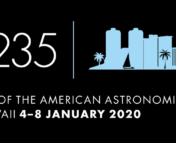In this series of posts, we sit down with a few of the keynote speakers of the 240th AAS meeting to learn more about them and their research. You can see a full schedule of their talks here, and read our other interviews here!

For today’s post, we interviewed Dr. Robert Lupton, a Senior Research Astronomer at Princeton. His research is about creating beautiful astronomical images like those you could see on Astronomy Picture of the Day (APOD). Getting mesmerizing images of galaxies is not as easy as taking a selfie though! You don’t get images right away — instead, you will first get data in the form of numbers: 0’s and 1’s. This is where Dr. Lupton comes in — he is responsible for converting bits of data from telescopes into science and the beautiful images we all know and love.
“There’s a star, there’s a galaxy – it’s a series of numbers. It’s somebody’s job to make sense of that. The data that actually comes off of the [telescope] camera doesn’t even look as beautiful as on your cell phone, because it’s got a lot of noise, which we have to take out,” says Lupton. “I took zeros and ones coming off a camera, cleaned them up, found the objects, measured their properties, and put them into a database. And then somebody else can go off and do interesting things.” An example of those “interesting things” is making huge catalogs of measured brightnesses and colors of hundreds of galaxies for the Sloan Digital Sky Survey, also known as SDSS. Lupton is also now a part of the Vera C. Rubin Observatory, home to the Large Synoptic Survey Telescope (LSST), which will address some of the most pressing questions about the structure and evolution of the universe and the objects in it.
Interested in everything!
Dr. Lupton hasn’t always been interested in astronomy. While I was talking to him, I realized that he is driven by interesting questions. Astronomy, fortunately, has a ton of them! He finished his undergraduate education in theoretical physics and was thinking of going to graduate school in solid state physics. “I ended up going to grad school in astronomy, however, I have always been interested in the natural world. I nearly became a geologist,” Dr. Lupton told me. He even mentioned that he thought he could end up a historian.
He was interested in history, geology, and astronomy and had a difficult time choosing from these different disciplines. However, his love for mathematics and the fact that astronomy didn’t have much competition at that time made it easier to choose. “I don’t know why I didn’t become a historian. I guess my brain works moderately mathematically. I’m not quite sure why I didn’t become a geologist, but one reason I chose to do astronomy was that astronomy was a very small field. Most papers were based on a small amount of data or a small amount of theory.”
What kind of astronomer are you?
Some people like dividing people into theorists and observers in astronomy, but Dr. Lupton thinks that the line between the two is blurred! He, for example, works a lot with data and statistics. It is not necessarily as “theoretical” as deriving equations but it’s not observational either. Some people might think of his approach as theoretical because rather than sitting and looking at stars through a telescope he uses statistics to infer some information from the existing data, but some might consider it observational just because the work involves data. So, it is hard to distinguish between the two when it comes to data-driven astronomers. We’re all just astronomers after all!
Because astronomers work with so much data, we sometimes consider other professions where we can use the same skills. In fact, it happens quite often because academia is so competitive, and a lot of astronomers decide to “leave the field” (see some beyond posts by astrobites on this topic!). Dr. Lupton faced that problem too. “I’ve certainly thought about that. There have certainly been times when it’s not been clear what I was going to do next. So I could have imagined going to data science. I would have been happy taking my skills into something else,” he says “For example, I think in the early days of genomics, it would have been fascinating to switch fields because I knew a lot of things that people didn’t understand about handling these data sets.” Eventually, though, he stayed in astronomy to answer more questions about the universe that no one else will be able to answer.
However, no matter what field you choose to go into, Lupton says the key to success is finding good people. “I’ve always worked with the best people in the world… I’ve enjoyed working with other people who are smarter than me,” he says. “I think what I would say is to work with the best people you can find, and they will bring you to a level you wouldn’t have reached by yourself…And don’t be intimidated by the fact they’re smarter than you. ”
To hear more about data reduction and analysis and how we get stunning images of the universe, be sure to attend Dr. Lupton’s Plenary Lecture at 4:40 PM ET on Monday, June 13 at #AAS240!
Astrobite edited by Briley Lewis
Featured image credit: AAS



